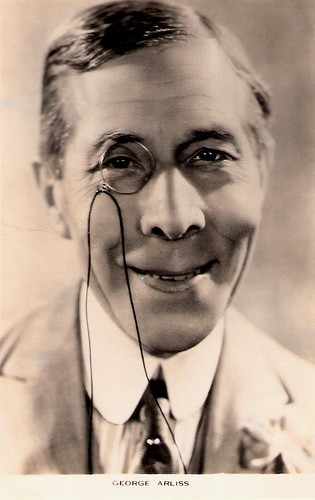
Vintage postcard.
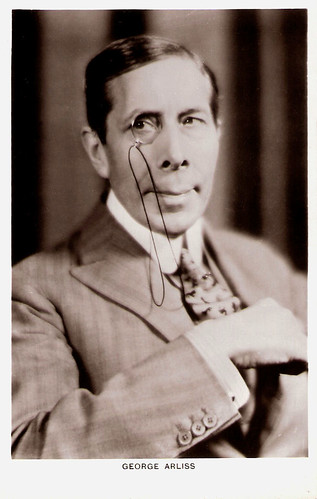
British postcard in the Picturegoer series, no. 473.
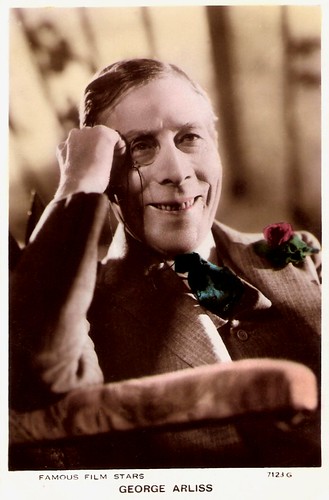
British postcard in the 'Famous Film Stars' series by Valentine, no. 7123G.
The Devil
George Arliss was born George Augustus Andrews in London, England, in 1868. His relatives referred to him as 'Uncle Gus'. He was educated at the renowned Harrow School and started work in the publishing office of his father, William Joseph Arliss Andrews. At age 18, he left to pursue an acting career on the stage.
Arliss began his stage career in 1887 in the British provinces. By 1900, he was playing London's West End in supporting roles. He embarked on a tour of America in 1901 in Mrs. Patrick Campbell's troupe.
Intending to remain in the USA only for the length of the tour, he stayed for twenty years. He made his Broadway debut in 'Magda'(1902). and eventually became a star on Broadway with the satiric drama 'The Devil' (1908), by Ferenc Molnar.
Producer George Tyler commissioned a play specifically tailored for Arliss in 1911 and the actor toured as Victorian-era British prime minister Benjamin Disraeli in 'Disraeli' for five years, eventually becoming closely identified with the 19th-century British prime minister.
He began his film career with The Devil (James Young, 1921), followed by Disraeli (Henry Kolker, 1921), and four other silent films. Today, only The Devil, Disraeli, The Green Goddess (Sidney Olcott, 1923), based on William Archer’s hit stage play, and Twenty Dollars a Week (F. Harmon Weight, 1924) with a young Ronald Colman as Arliss's character's son, are known to have survived.
In 1928, Arliss decided to accept a financially very lucrative offer of $100,000 for three sound films from Warner Brothers. He remade Disraeli (Alfred E. Green, 1929) in sound and won the Academy Award for Best Actor. In the same award season, he was also nominated for the remake of The Green Goddess (Alfred E. Green, 1930) with H.B. Warner, the original 1923 leading lady, Alice Joyce in her last film and Ralph Forbes. At the age of 61, Arliss converted successfully from a star of the legitimate theatre, then of silent films, and finally into the talkies.
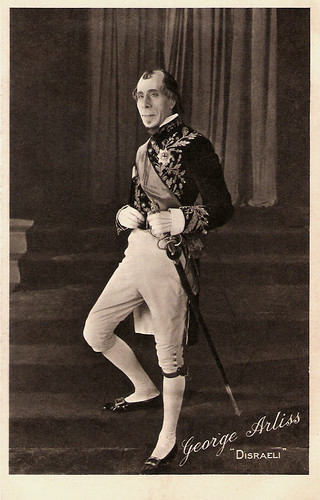
Vintage postcard. Photo: publicity still for Disraeli.
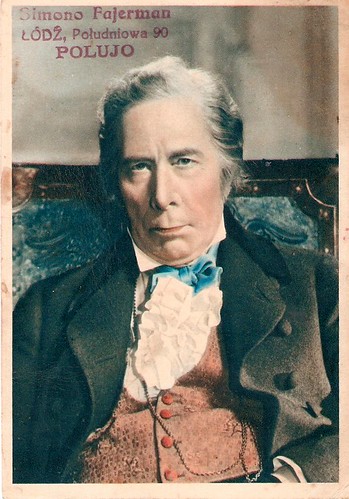
Polish postcard by De Reszke Minors Cigarettes. Photo: still from The House of Rothschild (Alfred L. Werker, 1934).
Creative control
George Arliss made ten sound films exclusively for Warner Bros. under a contract that gave the star an unusual amount of creative control over his films. Curiously, his casting of actors and rewriting of scripts were privileges granted him by the studio that are not even mentioned in his contract. He was granted the right to use the suffix "Mister" before his first name in the promotions for his films, a high honour granted by the studio to only a few stars, including John Barrymore and Ruth Chatterton, who was given the suffix "Miss".
Arliss built a production unit at Warners' both in front of and behind the cameras. Maude T. Howell, his stage manager, became an assistant producer and was one of the few female film executives in Hollywood at that time.
After his first three films, Arliss approved an undistinguished director, John Adolfi, to direct each of his films from that point on. Adolfi soon found himself regarded as a successful director of the critically and financially acclaimed Arliss films. However, his direction usually resulted in static productions that were more reminiscent of filmed theatre performances.
Arliss preferred to use the same reliable actors from film to film such as Ivan Simpson and Charles Evans. Yet he had an eye for discovering newcomers like James Cagney, Randolph Scott, and Dick Powell.
The Man Who Played God (John G. Adolfi, 1932) was Bette Davis' first leading role. In his autobiography 'My Ten Years in the Studios' (1940), Arliss told an anecdote about Bette Davis, who originally would play only a small supporting role in The Man Who Played God. Arliss reported that he had expected Davis to give an acceptable performance in an inherently boring role. In fact, he said, the young woman impressed him more than any other actress before her. Arliss was so taken with her that he insisted on expanding Davis' role. Davis was also later to speak very kindly of Arliss. In her own biography 'The Lonely Life', she said that she had acted in films she liked better, but that no other film had made as much of a professional difference to her as working with George Arliss in The Man, Who Played God. The two also co-starred in The Working Man (John G. Adolfi, 1933).
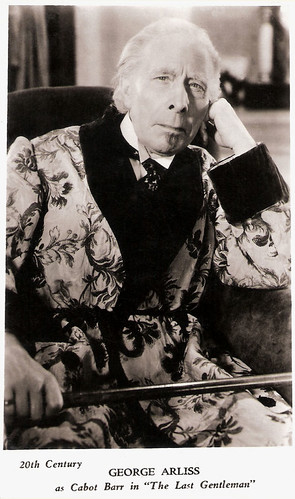
British card. Photo: 20th Century. Publicity still for The Last Gentleman (Sidney Lanfield, 1934).
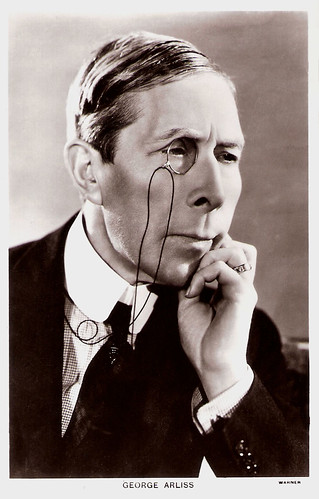
British postcard in the Picturegoer Series, London, no. 473a. Photo: Warner.

British postcard in the Picturegoer Series, London, no. 473b. Photo: Gainsborough.
A stolen star
Despite his extensive involvement in the planning and production of his films, George Arliss claimed credit only for acting. Working closely with Warners production chief, Darryl Zanuck, Arliss left the studio when Zanuck resigned in April 1933 and set up 20th Century Pictures which merged with the old Fox studios to 20th Century Fox only two years later. A month later John Adolfi died suddenly. Zanuck quickly signed Arliss to make new films at 20th Century Pictures, prompting Warners to bitterly complain to the Motion Picture Academy of Arts and Sciences that Zanuck had ‘stolen’ their star.
At 20th Century Fox, he played some of his best roles: the American politician Alexander Hamilton in Alexander Hamilton (John G. Adolfi, 1931), the renowned 18th-century French writer and philosopher Voltaire in Voltaire (John G. Adolfi, 1933), the European bankers Mayer and Nathan Rothschild in The House of Rothschild (Alfred L. Werker, 1934), the Duke of Wellington in the British The Iron Duke (Victor Saville, 1934), and the seventeenth-century French statesman Cardinal Richelieu in Cardinal Richelieu (Rowland V. Lee, 1935).
Arliss is remembered primarily for this witty series of historical biographies, but he had a second string to his bow, domestic comedies such as The Millionaire (John G. Adolfi, 1931), A Successful Calamity (John G. Adolfi, 1932), The Working Man (John G. Adolfi, 1933), and The Last Gentleman (Sidney Lanfield, 1934). In these films, he often appeared with his wife, Florence Arliss. In 1936 he went back to England at the request of his wife. In Great Britain, he made such films as the comedy The Guv'nor/Mr. Hobo (Milton Rosmer, 1935), the drama His Lordship (Herbert Mason, 1936) and East Meets West (Herbert Mason, 1936) with Lucie Mannheim. He was approaching 70 when he completed the also British-made Doctor Syn (Roy William Neill, 1937) with Margaret Lockwood and John Loder.
George and Flo returned to America later that year to visit old friends. Producer-director Cecil B. DeMille arranged for the Arlisses to re-enact their roles in Disraeli on Lux Radio Theatre, DeMille's popular radio show, in January 1938. The occasion was heralded as "a new page in radio history". George and Flo subsequently appeared on Lux in radio adaptations of The Man Who Played God in March 1938 and in Cardinal Richelieu in January 1939, which was apparently their final dramatic appearance anywhere.
Returning to their home in London in 1939, the onset of World War II prevented their return to America. In retirement, Arliss settled at Pangbourne in Berkshire. Arliss published a two-volume autobiography, 'Up the years from Bloomsbury' (1927) and 'My ten years in the studios' (1940). Film producer Darryl F. Zanuck tried to interest him in returning to Hollywood to star in The Pied Piper in 1942. Instead, Arliss lived out the Luftwaffe's Blitz on London. George Arliss died in Maida Hill in London of a bronchial ailment in 1946, aged 77. His gravestone spurns his success in the performing arts in favour of the one achievement of which he was apparently most proud: an honorary Master of Arts degree he received from Columbia University in 1919. He and Flo had no children.

British postcard by Film Weekly, London. Photo: Warner Bros. George Arliss as the title character in Voltaire (John G. Adolfi, 1933), based on the life of the famous French writer and philosopher. With Alan Mowbray as the perfidious count de Sarnac and Doris Kenyon as Mme de Pompadour. The focal problem is in the card itself.

British postcard by Film Weekly, London. Photo: Warner Bros. George Arliss as the title character, Doris Kenyon as Mme de Pompadour, Margaret Lindsay as Nanette, and Theodore Owen as François, Nanette's friend, in Voltaire (John G. Adolfi, 1933).

British postcard by Film Weekly, London. Photo: Warner Bros. Margaret Lindsay as Nanette, George Arliss as the title character, and Doris Kenyon as Mme de Pompadour in Voltaire (John G. Adolfi, 1933.
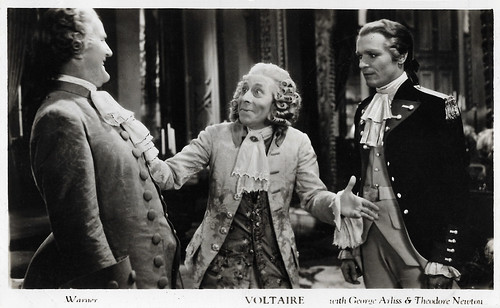
British postcard by Film Weekly, London. Photo: Warner Bros. George Arliss as the title character and (on the right) Theodore Newton as Nanette's friend François in Voltaire (John G. Adolfi, 1933).
The final scene from The House of Rothschild (Alfred L. Werker, 1934) with George Arliss and Loretta Young. This was one of the first live-action sequences in three-colour Technicolour. Source: Perfect Jazz (YouTube).
Sources: Wikipedia (English and Dutch) and IMDb.
This post was last updated on 22 April 2023.
No comments:
Post a Comment